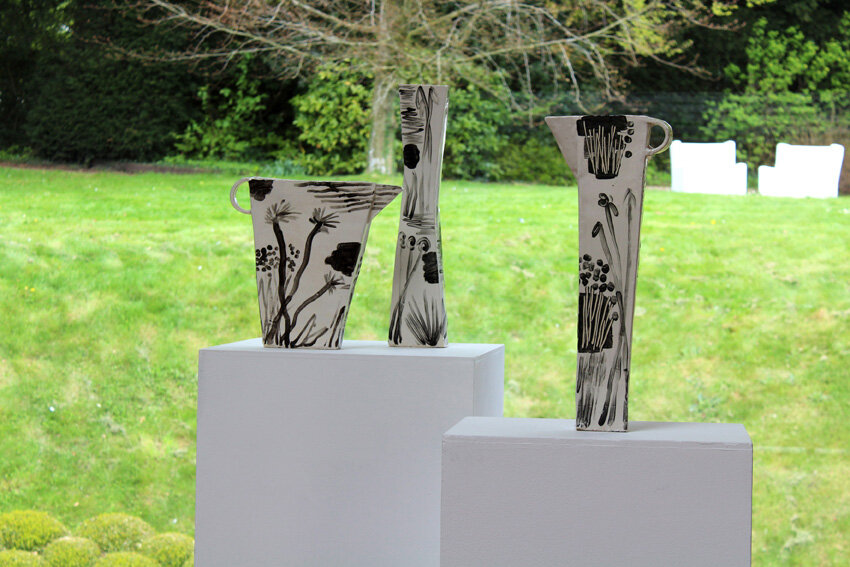Bruce McLean: Garden Ware Vessels, in the Artists House
Bruce McLean: Garden Ware Vessels, in the Artists House
Bruce McLean: Garden Ware Vessels
04 May – 03 Jun 2018
For this, his second exhibition at Roche Court, we are delighted that Bruce McLean will be showing a series of new jugs and vases in the Artists House. Ceramics have played an increasingly significant role in McLean's practice, which has been in an almost constant state of invention and re-invention, and currently includes performance, sculpture, installation, public art, painting, printmaking, drawing, photography and film as well as ceramics.
McLean's ceramics have proven controversial in the past, when in 1987 a three-foot tall sculpture with a large beaker and a small handle entered the collections of the V&A. Despite its apparent shortcomings as a functional jug, Oliver Watson - then the V&A's Chief Curator of the Ceramics and Glass Department - concluded his defence of the acquisition by declaring that Bruce McLean highlights the absurdity of the art / craft debate as he is "not a 'potter', but this is surely a good pot".
More than thirty years later, McLean has created a new body of work entitled Garden Ware. Restricted to a palette of black and white, each piece is unique with designs inspired by the flowers and plants of McLean's garden in Menorca. And whilst these new works may recall his first jug and the response it initially received, today we are surely more able to accept these works as sculpture, which is exactly what the artist intended.
Bruce McLean (b. 1944) studied at Glasgow School of Art from 1961 to 1963. From 1963 - 66 he attended St Martin's School of Art, London, where he famously reacted against the formalist academic teaching of teachers such as Anthony Caro, Phillip King and William Tucker. In 1966 he abandoned conventional studio practice for impermanent sculptures made using materials such as water, along with performances of a generally satirical and subversive nature. In 'Pose Work for Plinths I' (1971; London, Tate), photographs record a performance in which McLean appeared in a variety of different positions on plinths to parody the poses of Henry Moore's celebrated reclining figures. When in 1972 he was offered an exhibition at the Tate Gallery, he opted, with mocking intent, for a retrospective lasting only one day. He has continued to use humour to confront the pretensions of the art world and wider social issues such as the nature of bureaucracy and institutional politics. From the mid-1970s, while continuing to mount occasional performances, McLean turned increasingly to painting and most recently to ceramics.
McLean has participated in many major international exhibitions since the 1960s, highlights include: When Attitudes Become Form, Kunsthalle, Bern (1969); Information, Museum of Modern Art, New York (1970); The British Avant Garde, New York Cultural Centre (1971); Documenta 6, Kassel (1977); Art in the Seventies, Venice Biennale (1980); A New Spirit in Painting, Royal Academy, London; Zeitgeist, Martin-Gropius-Bau, Berlin (1982); Documenta 7, Museum Fredericianum, Kassel (1982); Thought and Action, Laforet Museum, Tokyo (1983); The Critical Eye, Yale Centre for British Art, New Haven (1984); Out of Actions; Between Performance and the Object, 1949-79, Museum of Contemporary Art, Los Angeles (1997); Bruce McLean and William Alsop, Two Chairs, Milton Keynes Gallery (2002) and Body and Void: Echoes of Moore in Contemporary Art, The Henry Moore Foundation, Hertfordshire (2014). McLean's work is in private and public collections around the world. In 1985 he was awarded the John Moore's Painting Prize. Bruce McLean's 100 Plates were commissioned by the British Ceramics Biennial and were shown in the gallery at the New Art Centre in 2016.


